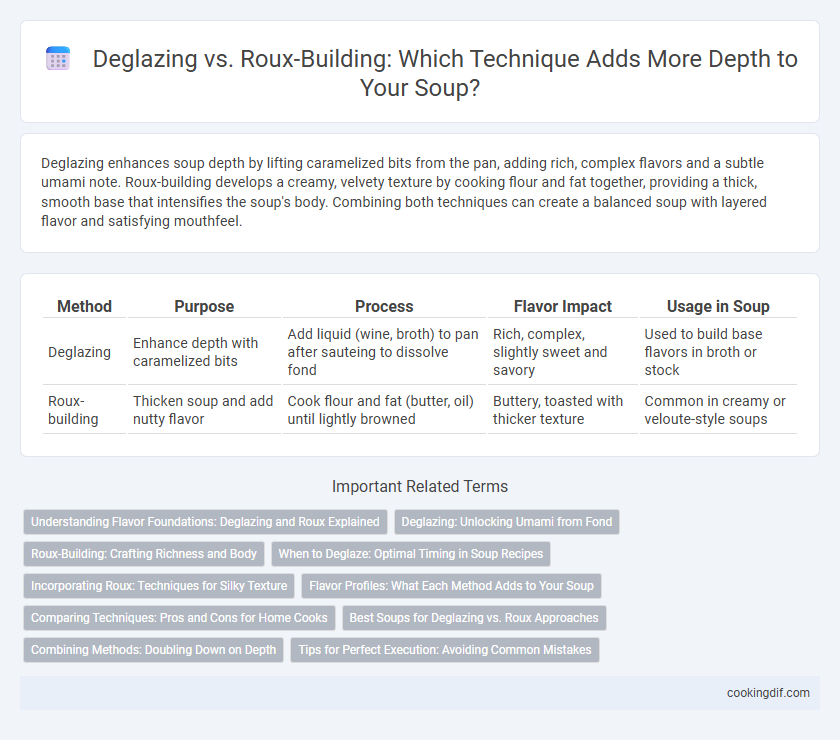Deglazing enhances soup depth by lifting caramelized bits from the pan, adding rich, complex flavors and a subtle umami note. Roux-building develops a creamy, velvety texture by cooking flour and fat together, providing a thick, smooth base that intensifies the soup's body. Combining both techniques can create a balanced soup with layered flavor and satisfying mouthfeel.
Table of Comparison
| Method | Purpose | Process | Flavor Impact | Usage in Soup |
|---|---|---|---|---|
| Deglazing | Enhance depth with caramelized bits | Add liquid (wine, broth) to pan after sauteing to dissolve fond | Rich, complex, slightly sweet and savory | Used to build base flavors in broth or stock |
| Roux-building | Thicken soup and add nutty flavor | Cook flour and fat (butter, oil) until lightly browned | Buttery, toasted with thicker texture | Common in creamy or veloute-style soups |
Understanding Flavor Foundations: Deglazing and Roux Explained
Deglazing involves adding liquid to a hot pan to dissolve browned food residues, creating a rich, savory base for soups that enhances depth and complexity. Roux-building combines equal parts fat and flour cooked together to thicken soups while imparting a smooth texture and subtle nutty flavor. Both techniques establish essential flavor foundations, with deglazing emphasizing intense, caramelized notes and roux-building providing body and richness.
Deglazing: Unlocking Umami from Fond
Deglazing enhances soup depth by dissolving fond--the caramelized bits stuck to the pan--into the liquid, unlocking rich umami flavors that intensify the broth. This technique captures complex Maillard reaction compounds, creating a savory base unmatched by roux-building alone. Using broth, wine, or vinegar to deglaze imparts acidity and moisture, balancing richness and layering taste complexity for a more robust soup.
Roux-Building: Crafting Richness and Body
Roux-building creates a foundational richness and body in soups by cooking equal parts fat and flour to form a thickening agent that enhances texture without diluting flavors. This method allows for gradual flavor development through browning, resulting in a velvety, cohesive consistency that supports complex ingredients. Unlike deglazing, which adds depth through pan drippings and liquids, roux-building provides a robust structure essential for creamy bisques and veloutes.
When to Deglaze: Optimal Timing in Soup Recipes
Deglazing should be done immediately after sauteing vegetables or browning meat to lift flavorful fond from the pan, enriching the soup's base with deep, caramelized notes. This process intensifies umami and adds complexity before adding broth or liquids, ensuring the soup's flavor develops fully. Use roux-building later if a thicker, creamier texture is desired, but deglazing remains crucial for capturing foundational savory depth early in the cooking sequence.
Incorporating Roux: Techniques for Silky Texture
Incorporating roux into soup involves cooking equal parts fat and flour to create a smooth, thick base that enhances silkiness and depth of flavor. Proper technique includes slowly whisking the roux into the broth to avoid lumps and simmering it to develop a rich, nutty taste. Unlike deglazing, which primarily lifts caramelized bits for immediate brightness, roux-building creates a sustained, velvety texture that builds body and complexity throughout the soup.
Flavor Profiles: What Each Method Adds to Your Soup
Deglazing enhances soup by incorporating rich, caramelized fond from the pan, adding a deep, concentrated umami flavor that intensifies the broth. Roux-building, a mixture of fat and flour cooked together, creates a smooth, velvety texture and imparts a subtle nutty undertone that thickens the soup while balancing its taste. Each technique uniquely contributes to the soup's complexity, with deglazing emphasizing robust depth and roux-building providing body and a creamy mouthfeel.
Comparing Techniques: Pros and Cons for Home Cooks
Deglazing enhances soup depth by dissolving browned bits with liquid, imparting rich flavor and complexity, ideal for quick preparation and bold taste. Roux-building thickens soup with a cooked mixture of fat and flour, creating a smooth, velvety texture and controlled consistency, but requires careful cooking to avoid bitterness. Home cooks benefit from deglazing for speed and flavor intensity, while roux offers precise texture control, making each technique uniquely suited for different soup styles.
Best Soups for Deglazing vs. Roux Approaches
Deglazing enhances soups like French onion or mushroom by lifting caramelized fond with wine or stock, intensifying umami and depth without added thickness. Roux-building suits creamy bisques and chowders, where a flour and fat base adds body and smoothness for a rich texture. Best soups for deglazing emphasize robust, clear broths while roux-driven recipes benefit from creamy, velvety consistency.
Combining Methods: Doubling Down on Depth
Combining deglazing and roux-building techniques enhances soup depth by integrating rich, caramelized flavors with a smooth, thickened texture. Deglazing captures browned bits from the pan, intensifying umami, while the roux adds stability and silkiness to the broth. Using both methods doubles the complexity and mouthfeel, resulting in robust, layered soups that elevate taste and consistency.
Tips for Perfect Execution: Avoiding Common Mistakes
Deglazing a pan with liquid like wine or broth dissolves flavorful browned bits, creating an intense base for soups, while roux-building blends fat and flour to thicken and add richness. For perfect execution, avoid overheating the roux to prevent bitterness and choose the right liquid temperature when deglazing to ensure smooth incorporation. Mastering these techniques enhances depth and texture without overwhelming your soup's flavor balance.
Deglazing vs Roux-building for depth Infographic

 cookingdif.com
cookingdif.com